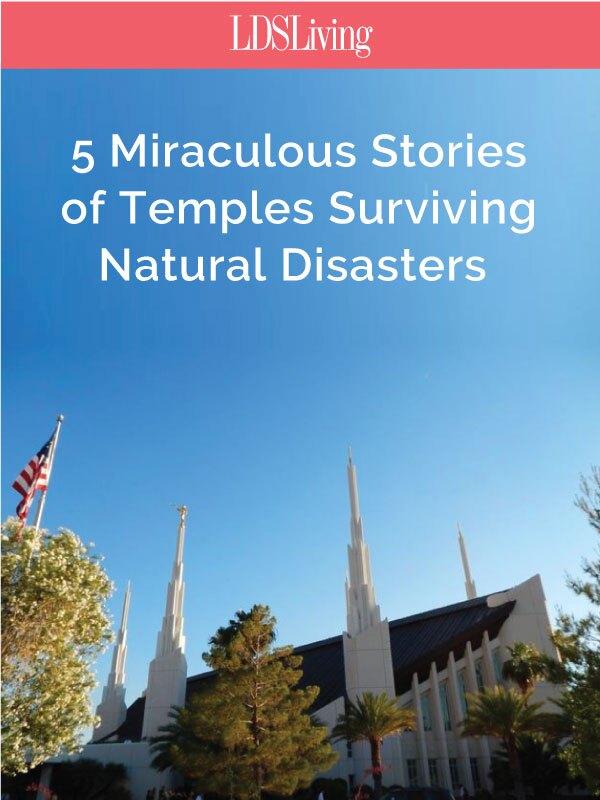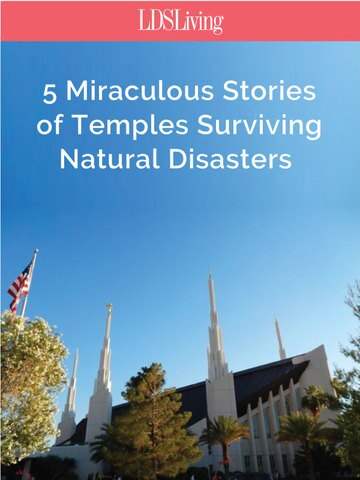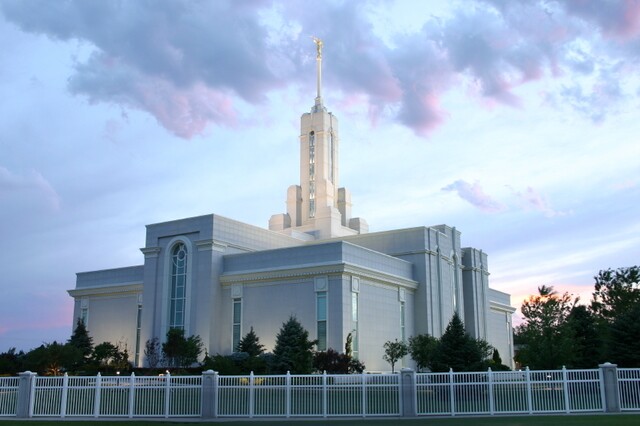
Through the years, temples have had direct or close encounters with brush fires, sand storms, tsunamis, blizzards, tornadoes, hurricanes/typhoons, flooding, and lightning strikes.
For the most part, the temples dotting the earth have withstood these forces with very few consequences. This is partly the result of the high level of construction integrity utilized in all of the latter-day temples. Brigham Young established this incredibly high construction standard starting with the Salt Lake Temple: “When the Temple is built I want it to stand through the millennium, in connection with many others that will yet be built.”
Today, temple builders have faithfully perpetuated this tradition of construction excellence. To protect against earthquakes, temples are often built to far exceed local seismic building codes. For example, although the Sao Paulo Brazil Temple was built in a region with minimal seismic activity, the foundation was built strong enough to sustain another 13 stories, making the structure virtually earthquake proof. The Redlands California Temple was built in an area frequented by many seismic events. According to the temple's construction missionary Elder Jerry Quinn, "The massive reinforced concrete foundation and walls create a building with a seismic rating designed to withstand two levels above the largest earthquake ever recorded in California. There has never been a recorded earthquake in California that would even touch this structure. Redlands’ City inspectors were so impressed with our building that they used photos and data from this building to show other contractors how they should build.” And while these temples are built sturdily, it doesn’t mean that others haven’t been damaged or affected by natural disasters. Here are some incredible stories from just a few.
IN THE PATH OF HURRICANES - Baton Rouge Louisiana Temple
In 2005, the Atlantic hurricane season proved to be the most active season in recorded history. Category 5 Hurricane Katrina was the costliest natural disaster in the history of the United States. President D. Gregory Brumfield and Sister Alicia Brumfield served as the temple's first President and Matron (2000-2005). Hurricane Katrina proved to be the most dramatic experience of their five years of service and occurred only months prior to their release. Of the experience, Sister Brumfield related the following: "The President and I knew the storm was coming so we went to the temple to lock it up and make sure everything was secure. Before we left, we said a prayer... you know if there is something large in a river, the river goes around the object on both sides... that is exactly what happened at the temple. The hurricane went around the temple on both sides and we sustained very little damage."
"After being closed for a couple of days we opened the temple. We only had a couple of temple workers but we knew we needed to be open for those who wanted to come to the temple. Our policy was, 'The Lord will provide and He will take care of us. We just need to move forward.' "
"As the temple matron, I watched my brothers and sisters come to the temple looking like zombies. Their home was gone, their neighbors were gone, their food storage is gone their genealogy is gone... they only had the clothes on their backs and nothing more. They had lost their facial expression. Think of someone who is disoriented but somehow knew where they needed to be. The temple was their refuge… As the matron, I would welcome them and give them a hug."
Three years later, in 2008, category 4 Hurricane Gustav's devastation also had an indirect impact on the temple. Immediately following the hurricane’s aftermath, thousands of member volunteers from the southern states descended upon the temple grounds to gather, pitch tents and prepare to serve the Baton Rouge community. The adjoining stake center served as a command center for the hurricane rescue and cleanup operation for the 2,000+ service requests. As volunteers pitched their tents on the temple property, they purposefully positioned their tent "door towards the temple" (See Mosiah 2:6).
The number of gathered volunteers necessitated that sacrament meeting be held outdoors on the temple grounds one Sabbath morning. Stake President Randall Bluth described the special experience, "It really was a remarkable event to look at the sea of yellow 'Helping Hands' t-shirts gathered on the hill around the temple. We didn’t have enough sacrament trays, so we used huge cookie sheets for the bread and water cups. Following the brief sacrament meeting, we all went out into the community and worked where needed."
"It was powerful. It is hard to describe in words what kind of an event that was... it just felt like the heavens opened as we were there to serve people after a disaster... and then to look over at the temple and realize that there is an eternal purpose for all that we do. It was unforgettable."
TSUNAMI DEVASTATION - Apia Samoa Temple
The 2009 Samoa earthquake and tsunami caused substantial damage and loss of life in Samoa and American Samoa. A few minutes after a devastating earthquake, waves reaching a height of 46 feet pounded the Samoan coast. The water raged inland wiping out villages causing at least 189 fatalities and leaving thousands of others homeless.
Located at roughly 2 feet above sea level and only a half a mile from the coast, the Apia Samoa Temple was in a potentially vulnerable position to the tsunami's deadly power. President J. Phillip Hanks and his wife, Dawn, were serving as Temple President and Matron of the Apia Samoa Temple at the time. President Hanks recorded: "I felt the earthquake for about three minutes. The noise of the earth's shaking sounded like a semi truck rushing by. We received an immediate tsunami warning and evacuated the temple. I planned on staying with the temple because of my stewardship. After being persuaded to leave, my wife and I drove inland and waited in our car. We soon learned that only five minutes after the earthquake, the tsunami had already struck the north side of the island." It was later determined that the temple only suffered minor quake damage, including the Angel Moroni's trumpet and thumb breaking off.
Many regularly temple-attending members lost their lives in the tragedy. One temple worker was caught in the forceful waves and washed into the top of a 30-foot tree. There she clung to the tree while the forceful waves rushed by. The next day, she returned to the temple and shared a deeply personal experience with Sister Hanks, who recalls that "the day before the tsunami, she [the sister temple worker] had performed temple ordinances for 23 sisters. While she was in the tree, she felt those same 23 sisters surrounding her in the top of that tree. As she waited for the water to subside, the sisters stayed with her and saved her life. The very next day, despite having lost her home, grandson and having no place to live, this faithful sister arrived back at the temple to serve at her regularly scheduled shift. It was her way of saying 'thank you for saving my life.'"
"It was a wake up call for a lot of people", President Hanks said. "For example, after the tragedy, those who were not yet sealed in the temple decided to do so... it was indeed their wake up call." An increased number of members sought refuge and peace in the temple following the unforgettable tragedy (J. Phillip Hanks and Dawn Hanks, recorded interview with Chad S. Hawkins, 15 April 2015).
A BEACON IN THE HURRICANE - Apia Samoa Temple
In December 1991, one of the worst tropical storms in recent history pummeled the islands of Western and American Samoa for five days. The storm, named Hurricane Val, was particularly discouraging because, after pounding the islands for two days, it seemed to weaken, providing a false sense of relief. Following the lull, however, the storm then turned a full loop and hit the islands again from different directions, with even stronger winds. The storm killed at least 17 people and damaged or destroyed more than 65 percent of the homes on the islands. Roads, hospitals, a fire station, and virtually all the island’s crops were destroyed. Downed telephone and utility lines made communication difficult.1
When the storm ended, it was found that all 69 of the Church’s meetinghouses in Western Samoa had sustained some damage; and most of the meetinghouses in American Samoa received major damage. Despite the havoc raging around it, the Apia Samoa Temple was protected, receiving a relatively small amount of water damage. Additionally, due to emergency generators, a light on the temple’s tower shone brightly during the storm. One member said: “It was about the only light in the whole end of the island. It stood out as a beacon in the storm.”
PRESERVED DURING AN EARTHQUAKE - Oaxaca Mexico Temple
Because earthquakes are an ever-present possibility in southern Mexico, the temple in Oaxaca was built on pilings to make it as earthquake proof as possible. But two major earthquakes tested the temple’s construction even before it was completed. The first—a 6.5 quake with its epicenter 200 miles north of Oaxaca—occurred in July 1999, as the temple’s footings were being put into place. Though little damage was sustained at that time, the next quake two months later was much closer and more severe. On September 30, as the temple’s exterior walls were nearing completion, a three-minute, 7.6 earthquake struck.
The temple’s project manager, Jay Erekson, described the event: “As we were running out of the temple, the ground was bucking up and down six to eight inches. I stood there and watched as the windows went out of square in both directions. The temple’s tower was whipping back and forth four or five feet. As I watched it happen, I started to cry because I thought, ‘Our temple is ruined.’ I thought we would have to tear it down and start over again.”
More than 100 buildings in the city were destroyed by the quake or damaged to the degree that they were later condemned. After the disaster, however, instruments were used to check every angle and line of the temple. “When we were through, we discovered that the temple had not moved a millimeter out of square or out of plumb. It was a miracle,” said Brother Erekson.
CELESTIAL WINDOWS PROTECTED DURING EARTHQUAKE - Las Vegas Nevada Temple
In October 1989, a 7.1-magnitude earthquake hit the San Francisco Bay Area just before the third game of the World Series at Candlestick Park. It was the worst earthquake since 1906, collapsing a section of the San Francisco–Oakland Bay Bridge and causing nearly $3 billion worth of damage in San Francisco alone.
On the day of the quake, the window that was to be hung in the celestial room of the Las Vegas Nevada Temple was in a glass factory in Santa Cruz, near the epicenter of the quake, hanging in a sling where it was scheduled to be polished and then shipped to the temple. It had taken six weeks to make the window, and the temple’s open house was only two weeks away. When the tremor hit, the window swung wildly, but amazingly escaped any damage. Other glass projects in the factory were shattered, ruined beyond repair but the special window arrived, intact, one week before the temple opened for public viewing.
The following is a brief list of other significant natural events and the temples they impacted:
Nauvoo Temple - Tornado (1850)
St. George Utah Temple - Lightning destroyed spire (1878)
Manti Utah Temple - Lightning struck east tower (1928)
Apia Samoa - Cyclone Val (1991)
Raleigh North Carolina Temple - Hurricane Floyd (Category 4) (1999)
Salt Lake Temple - Tornado damaged Temple Square (1999)
Baton Rouge Louisiana Temple - Hurricane Katrina (2005) Hurricane Gustav (2008)
Apia Samoa Temple, Tokyo Japan Temple, Santiago Chile Temple - Earthquakes caused Angel Moroni's trumpet to fall out of his grasp.
Multiple significant weather events have also impacted groundbreakings, temple open house, youth celebrations, and dedication events.
Lead image of the Las Vegas Nevada Temple fromldschurchtemples.com, by Seth Jensen.
Chad S. Hawkins is a well-known temple artist and historian whose career has taken him to six continents and over 100 temple locations. Chad’s artwork was selected and placed within the cornerstones of sixteen different temples. His latest Deseret Book publication, Temples of the New Millennium, includes his artwork, histories and fascinating facts of all 150 dedicated temples. Much of the information in this article is found in this inspiring new book. This significant publication celebrates the historic milestone of 150 dedicated temples. Learn more about his artwork at chadhawkins.com.




